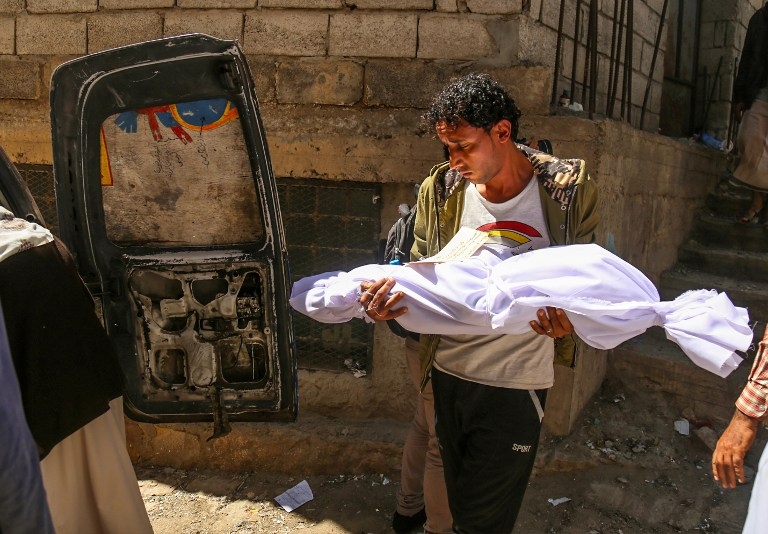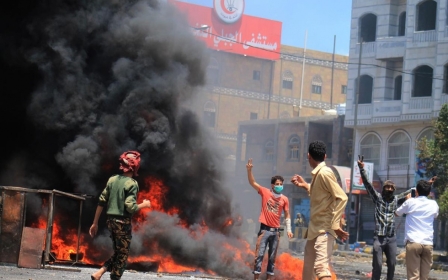Lost generation: Yemen's war takes its toll, even in the womb

TAIZ CITY, Yemen - Zaid al-Khameri buried the body of his stillborn child in a graveyard near the family home before finally taking his exhausted and traumatised wife Shorooq to hospital.
Zaid and Shorooq, 32 years old and then six months pregnant, were asleep with their two children when a rocket attack struck Yemeni city’s al-Rawdha area last October.
"She was used to hearing the sounds of rockets far from our house but this one came down right outside and broke all the windows,” Zaid told Middle East Eye.
“We were all scared but Shorooq and our child were the main victims of the attack. After three hours of suffering she lost the baby.”
With most of Taiz’s hospitals shut down by the war and movement for citizens restricted by roadblocks, it was morning before Zaid could take Shorooq to the city’s last operational maternity unit at al-Modhafar hospital.
“We already have two children so I can cope with losing the baby. I am more concerned about Shorooq,” said Zaid.
“She is suffering from psychological trauma. She shouts in her sleep as if she is a child. I’ve taken her to the doctor and now she is on medication. I hope she will recover eventually.”
Since April 2015, Taiz has been the scene of fierce fighting as Houthi rebels and fighters loyal to Saudi-backed President Abd Rabbuh Mansour Hadi have fought for control.
According to Fahd al-Saberi, the manager of al-Modhafar hospital, the war there has caused a surge of miscarriages, still births and neonatal deaths.
Some have been blamed on fear and trauma caused by Saudi air strikes and Houthi shelling, while others have been due to shortages of electricity and oxygen cylinders that have left hospitals unable to power the equipment necessary to look after premature infants.
Even al-Modhafar, which now deals with about 80 percent of all pregnancies in Taiz, regularly lacks fuel to power generators. Since the middle of February the hospital has partially relied on solar energy to remain operational.
At 6am on 18 January, 28-year-old Asrar al-Hagami went into labour two months early, shortly after an artillery attack in the al-Masbah area where she lived.
Asrar's husband Abdulwahed immediately took her al-Modhafar where their baby was born, only to die two hours later.
“The baby was born alive in the hospital, but there was no electricity to operate the incubators,” Abdulwahed told MEE.
Saberi said that at least 208 women had gone into premature labour at al-Modhafar because of war-related stress and fear in 2015, compared with just one recorded case in 2014.
"Sometimes if the pregnancy is in the seventh month, we can rescue the baby and it can live, but mostly they die either because they are insufficiently developed or because there is no electricity or oxygen,” he said.
But he added that the total number of women affected was likely much higher. At least 42 women had registered stillbirths at home because they had been unable to reach the hospital, and Saberi said that many other undocumented cases had probably also occurred.
'Hidden victims'
Soaad Qasem, the head of the Yemeni Midwives Association in Sanaa, the capital, said that an increase in miscarriages and stillbirths had been reported in all provinces affected by the war, with fear caused by shelling, air strikes and clashes often cited as the cause.
Although statistics for 2015 were still being compiled, she said anecdotal reports suggested a sharp rise in Taiz and Aden, which have both been the scene of heavy fighting.
“Pregnant women are the hidden victims of the war,” she told MEE. “The politicians and the humanitarian organisations talk about different issues caused by the conflict like refugees or the plight of children but they do not highlight this issue. These women need psychological support for the trauma and loss they have suffered.”
Vivette Glover, a professor of perinatal psychobiology at Imperial College London, told MEE it was entirely plausible that fear and trauma suffered as a result of war could cause pregnancy-related complications.
“There is lots of evidence that stress can bring on premature labour or later miscarriage and stress levels in these cases would be very, very extreme,” she said.
Glover said research also suggested that children whose mothers experienced war-related stress during pregnancy would be more at risk of experiencing problems in later life ranging from attention deficit hyperactivity disorder (ADHD) to being more fearful or having learning difficulties.
A study conducted in Israel after the 1967 Six-Day War found that children whose mothers were pregnant during the conflict had more cognitive and behavioural problems than those born two years later, she said.
“The next generation is likely to have a whole lot of emotional, behavioural and cognitive problems too,” Glover said.
The war in Taiz has also increased the risks associated with pregnancy and childbirth for women, according to the UN Population Fund (UNFPA), an agency focused on women's reproductive health.
It said earlier this month there were an estimated 90,000 pregnant women in Taiz city alone, with 4,500 of them facing the risk of death due to complications during childbirth in the next nine months.
“For women and adolescent girls, the advent of a crisis can lead to an even greater risk of sexually transmitted infections, including HIV, unintended and unwanted pregnancy, maternal morbidity and maternal mortality, as well as other risks to the health of mothers and newborns,” Lankani Sikurajapathy of the UNFPA told MEE.
The UNFPA said it planned to distribute life-saving medicines to health facilities across Yemen to meet the needs of more than half a million pregnant women.
Middle East Eye propose une couverture et une analyse indépendantes et incomparables du Moyen-Orient, de l’Afrique du Nord et d’autres régions du monde. Pour en savoir plus sur la reprise de ce contenu et les frais qui s’appliquent, veuillez remplir ce formulaire [en anglais]. Pour en savoir plus sur MEE, cliquez ici [en anglais].




